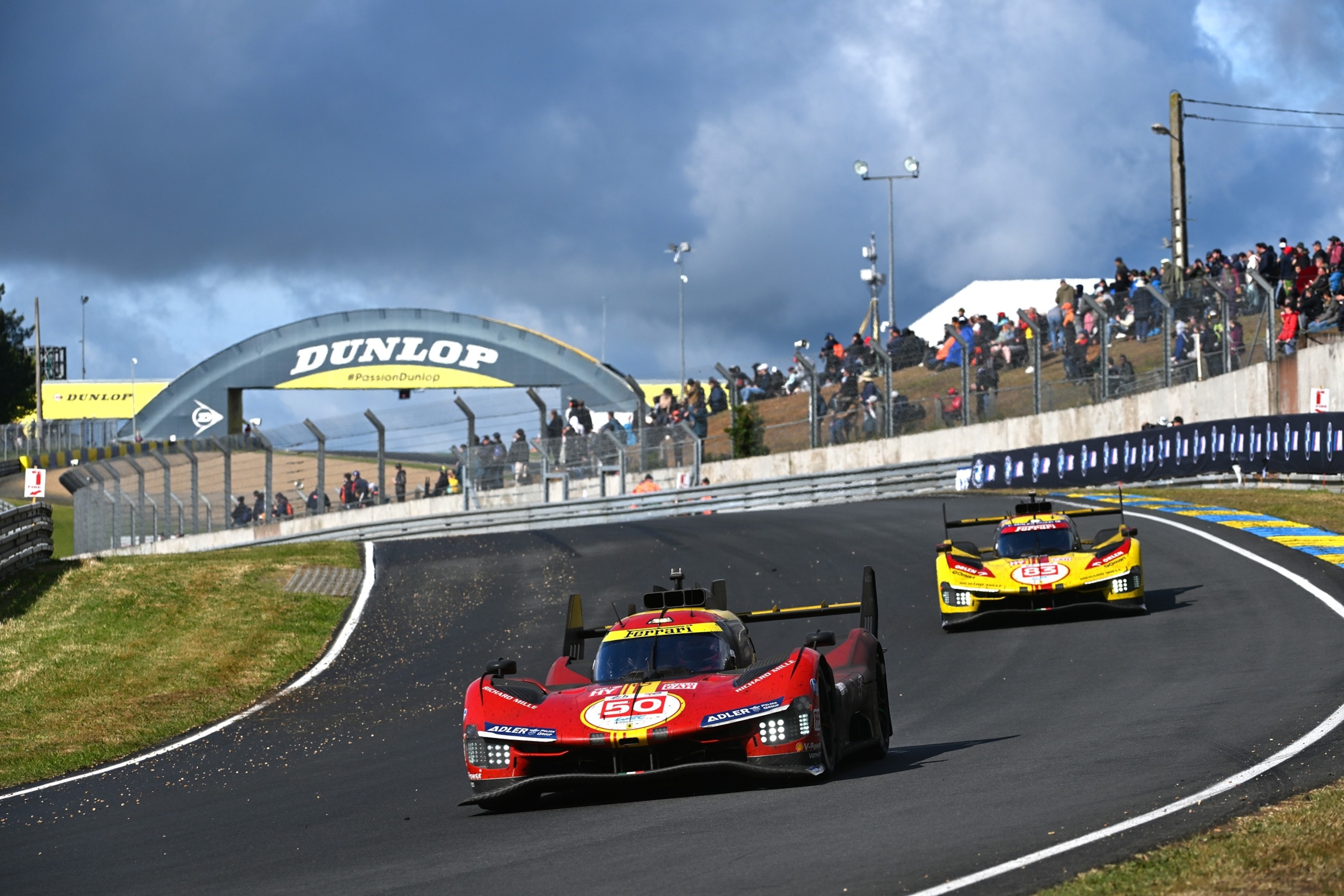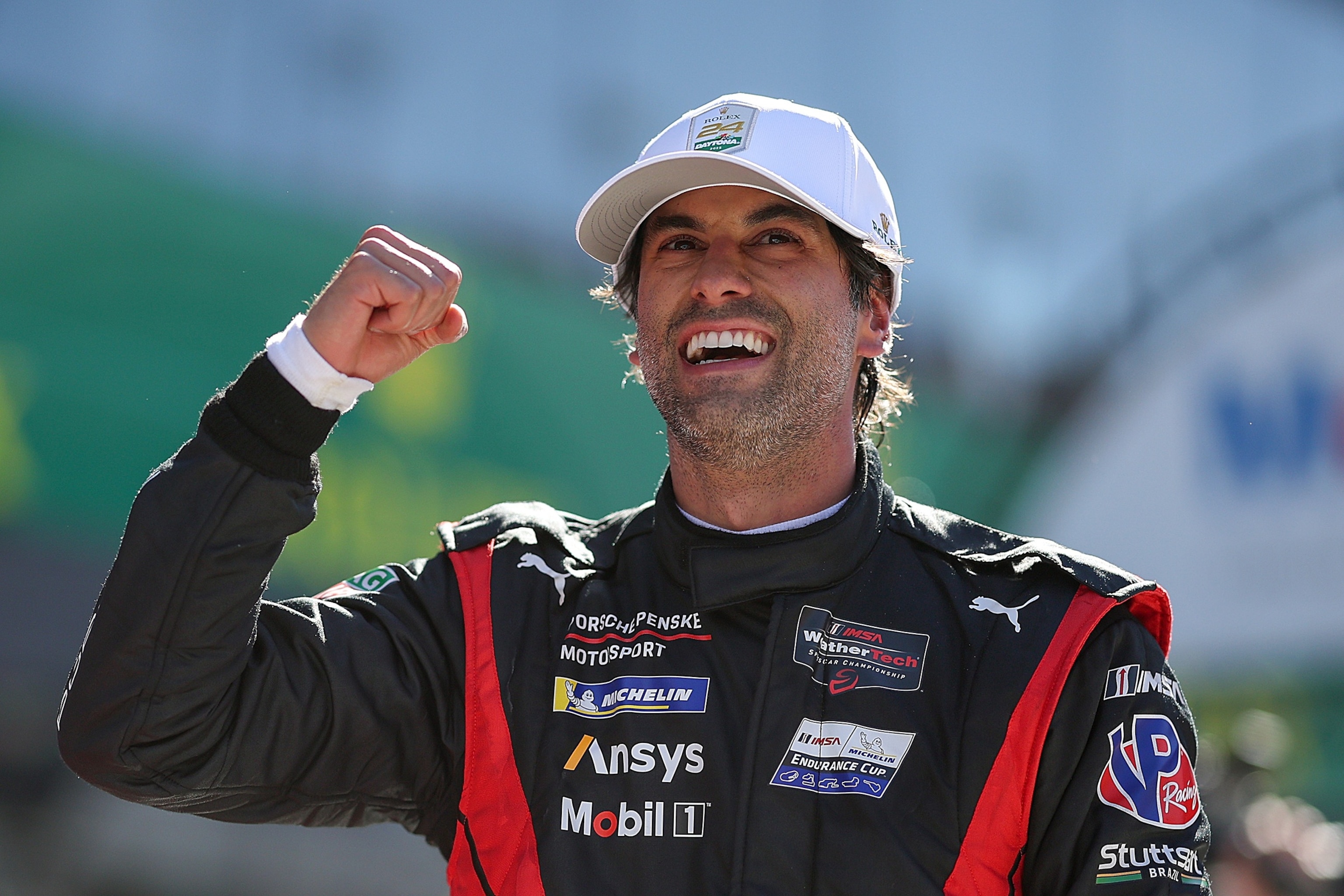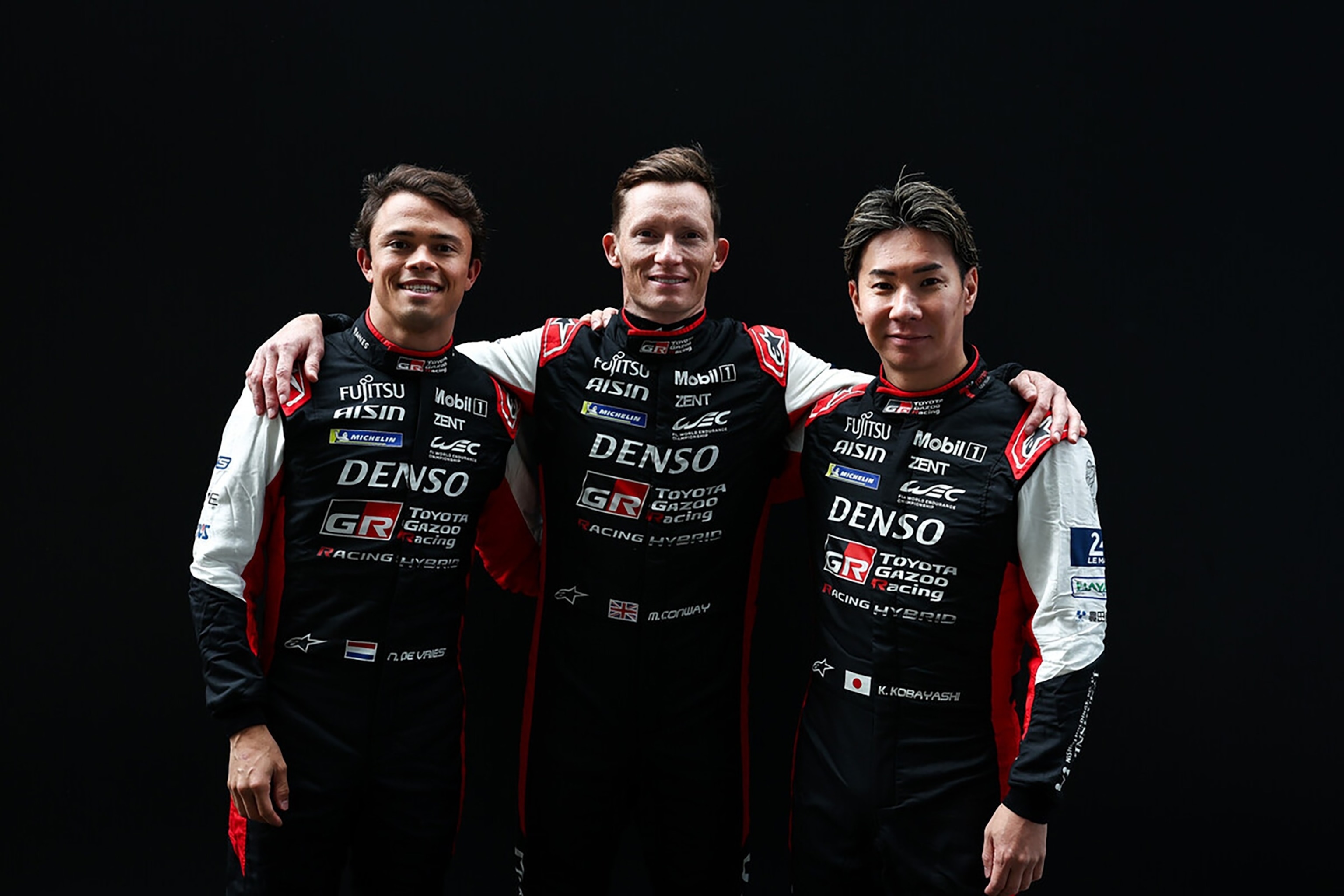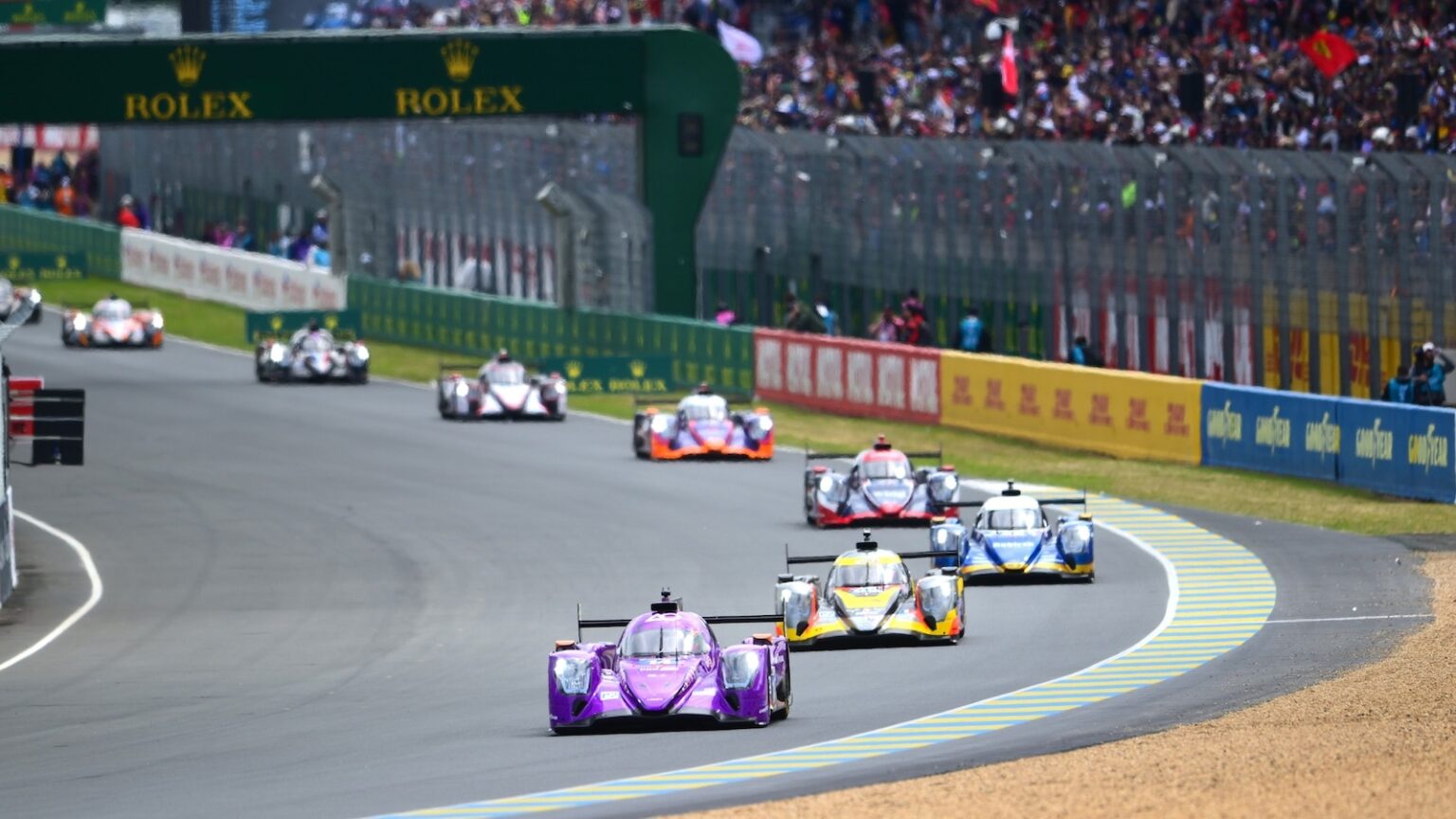What’s the formula for winning the world’s most famous endurance sports car race? Discipline, determination, intense training — and a little bit of luck.
Sixty-two teams consisting of 186 drivers will fight for that glory and prestige this Saturday, when the 93rd 24 Hours of Le Mans begins. The various teams, divided into three race classes — Hypercar (the top class), LMP2 and LMGT3 — will experience the toughest 24 hours of their life. All the pain and anguish, however, will pay off when the drivers stand on the podium and hoist the coveted winners’ trophy.
“Le Mans is a jewel,” Oliver Gavin, a five-time 24 Hours of Le Mans winner, told ABC News. “There’s a lot of pressure, a lot of mental strain plus the physical toll … it can be a really intense in the car. Your senses are overloaded with everything you’re feeling and seeing.”
British racing driver Oliver Gavin has won the prestigious 24 Hours of Le Mans five times. He’s seen here on the podium in 2015, his fifth and final win.
macleanphotographic.com
Gavin said he would rely on acupuncture to help relax when he was not chasing his competition on the circuit. Figuring out how to sleep when your teammate is behind the wheel may be even more daunting than driving in torrid rain or sweltering heat, he acknowledged.
“It was a lot of trial and error for me — I tried all lotions and potions,” Gavin recalled. “Acupuncture worked … I would have needles in my face, feet and shoulders. It helped me shut down for a couple of hours and helped me come down from the buzz and adrenaline.”
He went on, “Young drivers are desperate to do well. My advice — remove yourself from the pit box and make sure you go somewhere where you can fully shut down. Get out of garage and stop watching the timing screen.”
Caffeine may seem like a miracle drug for drivers fighting to stay alert at 3 a.m. but regulating caffeine intake is essential, according to Dr. Brian Krabak, a clinical professor of rehabilitation, orthopedics and sports medicine at the University of Washington and Seattle Children’s Hospital.
“You can lose that quick agility and reaction time with sleep deprivation, which could lead to injury,” Krabak told ABC News. “Drivers have to train with caffeine — you can’t throw that in on race day. Too much caffeine can affect the cardiovascular system. Rookies will get into trouble if they try something new.”
Krabak noted that drivers’ bodies sustain strong g-forces as they speed around the 8.5-mile circuit, requiring them to develop good endurance training programs months and years prior to Le Mans.
“Drivers have to be well-trained in terms of strength and flexibility,” he said. “Your head is bopping around even with a helmet on.”
Dr. Jade Cobern, a board-certified physician in preventive medicine and an ABC News Medical Unit fellow, added that a driver’s physical and mental fatigue can be dangerous in high-stakes environs, like Le Mans.
“The teams have to perform at such high levels for a long time,” she said. “Driving at high speeds and in unpredictable conditions plus the lack of sleep can lead to errors that have consequences.”
Several drivers taking part in Le Mans spoke to ABC News ahead of the race. Here’s what they revealed about their training, preparation and state of mind, in their own words. The following has been edited.

The 92nd edition of the Le Mans 24 Hours, 4th round of the FIA WEC 2024 World Endurance Championship, Race, Circuit des 24H du Mans, 15-16 June 2024, in Le Mans, France.
Eurasia Sport Images/Getty Images, FILE
Alex Lynn, 2020 Le Mans winner (LMGTE Pro class), competing in the No. 12 Cadillac V-Series.R
Alex Lynn, who won Le Mans in the LMGTE Pro class in 2020, is now in his second season with Cadillac Racing.
Drew Gibson
The race takes your mind and body to the limit. Every year you always find something new to do better. This year, for me, is about mobility — mainly my upper back. I am trying to get more movement.
When you’re stuck in a race car that doesn’t have a lot of space for a long time, lots of things cramp up. My hands and feet cramp up toward at the end of the race, when it’s most pivotal [for the team].
I am trying to improve my mental capacity and energy over the race week. We have a unique schedule — practices from 10 p.m. to 12 a.m., so you eat late.
Day or night, dry or wet conditions — you have to be comfortable in anything. To win the race you have to feel confident in any condition.
For mental focus, you really have lean into the training you’ve been putting in. Last year I made a big step by bringing my own personal trainer to the event. He’s dedicated to me and wakes me up. I won’t set the alarm. This is how I maximize rest. In past races I was scared I wouldn’t wake up.
When I wake up, I treat it like a new day. I brush my teeth, shower, put on aftershave, do my hair, put on a fresh T-shirt, even if it’s only 1 a.m. and I have to sleep again.
Last year there was a long safety car due to bad weather conditions. Alex Palou was in there for hours … I had the music on, trying to stay amped up [before switching].
I love coffee, but it does get to a point where you’re so fatigued that it makes you feel sick. Even consuming meat [during the race] becomes difficult, it’s tough to process in the body. I rely a lot on protein drinks, it’s easier on the stomach.
Sim training is an important tool for this race, I have my own simulator.
The circuit is beautiful and amazing to drive. The crowd is unbelievable … the atmosphere is unlike anything we experience for the rest of the year. I will have my family and girlfriend there, it’s nice to have support and loved ones to share the moment with you. I dream of winning again … but I recognize we’re very lucky to be able to do this.
Felipe Nasr, 2024 and 2025 winner of the 24 Hours of Daytona, competing in the No. 4 Porsche 963

Felipe Nasr, driver of the #7 Porsche Penske Motorsports Porsche 963, celebrates after winning the Rolex 24 at Daytona, Jan. 26, 2025, in Daytona Beach, Fla.
James Gilbert/Getty Images
Endurance racing by far is the most extreme, the most dynamic discipline. The demands are different, you stay in the car for so long. I am chasing that victory in Le Mans.
Just before I get into the car, I like to be in my own corner and visualize myself tightening the seat belt, plugging in the radio, leaving the pit lane and driving a lap — I do this over and over all weekend. I am aligning my body and mind before jumping in [the car]. I concentrate on my breathing techniques — I want to get in the right flow.
The adrenaline is so high in the car — there’s so much information going on in your mind. When I get out, I talk to my team and give them feedback. After driving for two or more hours, I have burned 1,000 calories. Hydration is key. When I get back to my RV, I’ll get a session in with my physio. I want to get deep into relaxation, bringing my heartbeat back to baseline.
I’ll get a call 1.5 hours before I have to be in the garage again. I take a cold shower and do a few exercises to get my body going again. The warm-up takes 5-10 minutes and I also drink coffee to warm up, I am a big fan of coffee. But if you drink too much you might get agitated. I am a big fan of fruits, they’re easy to digest. I’ll eat granola, peanut butter, chia pudding with almond milk. I’ll eat a lot in a race like Le Mans. My parents are always asking how I eat all of that food.
But I try to eat at least two hours before I jump in the car again, so I can digest.
Early morning hours are the trickiest; 3 a.m. to 6 a.m. are the worst times [of the race]. It’s hard on the transitions. We try to keep the driver rotations the same — if I drive at night, I will drive only at night. Another driver on the team will only race in the daytime.
I try to keep my training consistent — I don’t try to overtrain before a race like this. Every IMSA race is a test, a preparation for Le Mans. I do weights and functional training, mobility training and stretching. Sometimes I play tennis.
The work is no different from what we have been doing every weekend. I am very attune with myself and the team.
Jamie Chadwick, Triple W series champion, competing in her first Le Mans in the No. 18 Oreca 07-Gibson
Triple W series champion Jamie Chadwick will be competing in her first Le Mans this year with 2019 winners IDEC Sport.
IDEC Sport Paola De Palmas
I’ve been fortunate by having good access to some great drivers like Tom Kristensen, Mark Webber and Jensen Button. My teammate, André Lotterer, is also a three-time Le Mans winner.
I’ve been managing my energy — it’s a long week of buildup before the actual race. I am keeping enough [energy] in the tank for Saturday.
Driving at night is a completely different beast … I don’t have a lot of experience driving at night and will have to do a good bit of it in this race.
There’s a lot I still don’t know, like when to take the risk and when not to. I just want to keep pushing.
I won’t have much time to sleep and will be caffeinating for 24 hours. I have to manage that to make sure I don’t crash. I am bringing my own coffee machine, which I packed in the car. It’s about finding a bit of comfort in something uncomfortable.
My training has changed. I have focused on endurance, like trail running. That requires a lot of mental focus. I also love cycling.
I am more excited than nervous to be honest. I just want to enjoy the race. I’ve never driven at Le Mans, so there’s been a lot of sim training. It’s the best way to learn the circuit.
I have a few friends and family coming to the race. I just want to finish and have a solid result. I am excited about the challenge of Le Mans. It will be tough, and I’ll be relying on a lot of adrenaline. It’s 24 hours of my life.
Mike Conway, 2021 Le Mans winner (Hypercar class), competing in the No. 7 Toyota GR010 Hybrid

Nyck de Vries, left, Kamui Kobayashi, center, and Mike Conway, right, will be competing in Toyota Gazoo Racing’s No. 7 car.
Toyota Gazoo Racing
The competition is tougher this year with 21 Hypercars.
The pressure [to win] never goes away completely. I try to put the distractions aside. Every year you learn more about yourself and incorporate something differently.
I got injured last year so I missed Le Mans. I had a broken collar bone and broken ribs. That injury changed my approach to fitness. Before, I was just doing miles on the bike and maybe some swimming. I am making sure my body is stronger now.
I am still trying to figure out how to sleep during the race to be honest. I really don’t sleep much, though I want to. When I get out of the car, I am still pumped from what just happened. It’s so easy to look at the TV and listen to the radio … sometimes I can’t switch off.
Once I have eaten, I do feel more relaxed. I’ll shower, put on comfortable clothes and lie down on the bed. It’s very hard to sleep when the sun is up. We can black out the rooms but I still know it’s light outside. I’ve had nightmares and dreams where I have missed things or I am late for something.
The first thing I think of when I stop driving is hydration. I try to drink when I am in the car, forcing the fluids in and getting plenty of electrolytes. We have a guy here who tests our hydration levels when the race starts.
I always bring creature comforts to the race, like my pillow. I also bring food and drinks with me. My diet is a bit of a pain. I am gluten free now. I cut out gluten for health reasons this year. Bringing these items eases my mind a bit — I have everything here with me.
Nyck de Vries, competing in the No. 7 Toyota GR010 Hybrid
This is my sixth time competing at Le Mans. My preparation hasn’t really changed [from prior years]. It helps to have that experience — it gives you a level of confidence. I have a better understanding of what to expect.
There’s so much work that goes into the race … everything that happens before [the start] is equally as important. There are lots of different variables … from the moment I get here I try to isolate.
I don’t have any specific routines. I’ll quickly see the engineers after I jump out of the car and debrief with them. I then eat and shower. I’ll put on my underwear for my next stint in the car. Then I try to go to bed. This year I am not setting an alarm. I am having the physios wake me up 50 minutes before I need to be ready. I won’t shower again but go right to the garage and put my suit on.
I don’t drink coffee. I look at it as a new race every time I jump in the car.
I value sleep over everything. It’s a very long week, a long race. I try to catch up on sleep whenever I can. When I see a gap, I take a nap.
I definitely have done sim training. But the prep for Le Mans starts way ahead of the actual event. The team has been here for three weeks. I am racing in two series, so that’s means more track time, which is valuable. The more you race, the more you train.
The post ’24 hours of my life’: What it takes to finish Le Mans, the world’s most famous endurance race appeared first on abcnews.go.com

